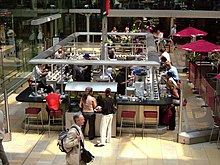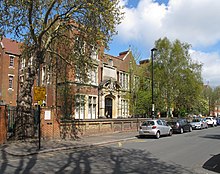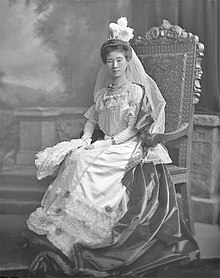
Golders Green is an area in the London Borough of Barnet in England. A smaller suburban linear settlement, near a farm and public grazing area green of medieval origins, dates to the early 19th century. Its bulk forms a late 19th century and early 20th century suburb with a commercial crossroads. The rest is of later build. It is centred approximately 6 miles (9 km) north west of Charing Cross on the intersection of Golders Green Road and Finchley Road.

Waitrose & Partners is a brand of British supermarkets, founded in 1904 as Waite, Rose & Taylor, later shortened to Waitrose. It was acquired in 1937 by employee-owned retailer John Lewis Partnership, which still sells groceries under the brand. Its head offices are located in Bracknell and Victoria, England.
A chain store or retail chain is a retail outlet in which several locations share a brand, central management and standardized business practices. They have come to dominate the retail and dining markets and many service categories, in many parts of the world. A franchise retail establishment is one form of a chain store. In 2005, the world's largest retail chain, Walmart, became the world's largest corporation based on gross sales.

Manchester City Centre is the central business district of Manchester, England, within the confines of Great Ancoats Street, A6042 Trinity Way, and A57(M) Mancunian Way, which collectively form an inner ring road. The City Centre ward had a population of 17,861 at the 2011 census.

Japan–United Kingdom relations are the bilateral and diplomatic relations between Japan and the United Kingdom.

Wagamama is a British restaurant chain, serving Asian food based on Japanese cuisine.

Oriental City was a major shopping centre in Colindale, North London, England, originally built as a luxury Japanese shopping centre called Yaohan Plaza by the Yaohan retail company of Japan. After Yaohan filed for bankruptcy in 1997, the centre became a lower-end mall specialising in various oriental foods and items, while also containing health and social services for the East Asian community. Opening in 1993, the 141,000 sq ft complex was located at 399 Edgware Road with a dedicated car park and two floors.
The first Japanese students in the United Kingdom arrived in the nineteenth century, sent to study at University College London by the Chōshū and Satsuma domains, then the Bakufu (Shogunate). Many went on to study at Cambridge University and a smaller number at Oxford University until the end of the Meiji period. The primary motive for this was an effort to modernise Japan in the long run. Since the 1980s, Japanese students in the United Kingdom have become common thanks to cheaper air travel.

The O2 Centre is an indoor shopping and entertainment centre that is open for around 18 hours per day located on Finchley Road in North West London, near Hampstead, England.

Japanese in the United Kingdom include British citizens of Japanese ancestry or permanent residents of Japanese birth or citizenship, as well as expatriate business professionals and their dependents on limited-term employment visas, students, trainees and young people participating in the UK government-sponsored Youth Mobility Scheme.

Nihon Ōdai Ichiran, The Table of the Rulers of Japan, is a 17th-century chronicle of the serial reigns of Japanese emperors with brief notes about some of the noteworthy events or other happenings.

Croydon, located in Greater London, England, has a diverse economy with the service and retail sectors now dominating over the town's historical market status. It is today served well by its extensive rail network centering on East and West Croydon stations, from where London Overground, First Capital Connect and Southern operate to most parts of Central and Greater London, as well as Surrey, Sussex, Hampshire and the East of England. With the A23, M23 and M25 orbital motorway intersecting Croydon to the South East, it is the principal gateway of the motorway network from the East Sussex area of the South Coast. London Gatwick Airport is located to the direct south of the town and has scheduled flights to destinations within Europe, North America and Asia, although has tough competition from the even bigger London Heathrow Airport to the west but has managed to stay the UK's second busiest airport. The town has since 2000 had a tram network which has been highly successful, carrying more than 24 million passengers a year. The network has three lines, the routes being; New Addington to West Croydon, Wimbledon to Beckenham and Wimbledon to Elmers End, with some off-peak variations. Croydon is one of only five London boroughs not to have any form of London Underground services.
Fujio Shido was a Japanese chef who played an important role in introducing French cuisine to Japan. When he was in his early 20s, he stowed away on a ship going to London, where he was deported. However, on his trip back to Japan, he escaped the ship when it stopped in Marseilles, eventually making his way to Paris. There he studied as the Le Cordon Bleu cooking school.
South Acton is an area in Acton, West London, 6.4 miles (10.3 km) west of Charing Cross. At the 2001 census, Acton, comprising the wards of East Acton, Acton Central, South Acton and Southfield, had a population of 53,689 people.

London has become one of the most ethnically diverse cities in the world with over 300 languages are spoken in Greater London.

Metropolis International Group Limited, established in 1994, is a predominantly UK-based media and technology group that specializes in business, consumer, and travel media including awards, events, websites, business software, and reward and benefit programs. It currently has 300 employees with offices in West London, Croydon, Bolton, Chester, Dublin, Acton and New York City. The company's headquarters are currently located in Acton and West London.

The Japanese School in London is a Japanese international school in Acton, London Borough of Ealing. The school is incorporated as The Japanese School Limited. The Japanese Saturday School in London, a Japanese supplementary school, is a part of the institution.
Asif Aziz is a London-based billionaire entrepreneur and philanthropist. As the founder and Chief Executive of Criterion Capital, he is known for owning and operating key landmarks including the London Trocadero and Criterion Building in Piccadilly Circus. Aziz is also the founder of family based charity the Aziz Foundation.
Japanese Bankers in the City of London: Language, Culture and Identity in the Japanese Diaspora is a 2000 nonfiction book by Junko Sakai, published by Routledge. This book describes the lives and cultures of employees at Japanese companies working in their London offices, mostly within the City of London, and includes Japanese and British employees.

Boxpark is a food and retail park made out of refitted shipping containers in Britain. It was founded by Roger Wade, who described it as the "world's first pop-up mall". The first Boxpark was launched in Shoreditch in 2011, another was built in Croydon next to East Croydon station in 2016, and a third opened in Wembley in late 2018. Other Boxparks are also planned for other cities and countries.


















